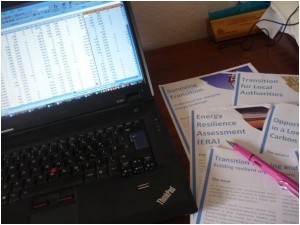Context:
Vital to successful Transition is WORKING WITH LOCAL BUSINESSES, and engaging them in STRATEGIC THINKING and helping them to see their role in that. Energy Resilience Assessments offer a great tool for MEASUREMENT of the degree of a business’s vulnerability, and enables the formulation of practical solutions. This work can be a very useful part of your AWARENESS RAISING work, especially with businesses, and can also be a good way of ENGAGING THE COUNCIL.
(We are collecting and discussing these Transition ingredients on Transition Network’s website to keep all comments in one place. Please leave feedback and comments, suggestions for alternative pictures, anecdotes, stories and projects for this ingredient here).
The challenge:
Transitioning the business sector is a key part of the Transition process. Many environmentalists see business as the problem and retreat into cynicism rather than fruitful engagement. The Transition model and practice for communities are not suitable for most businesses. It talks the wrong language and is not focussed on businesses concerns. Without tools that businesses can relate to and see as relevant, Transition is doomed, in the eyes of the business community at least, to be seen as irrelevant.
Core Text
Energy Resilience Assessment (ERA) is a tool developed by Transition Training and Consulting (TTandC) for use with businesses and organisations. It is based on the observation that in a time of rising and volatile energy prices, a business’s reliance on fossil fuels, especially liquid fuels, comprises a key vulnerability to that business. This reflects a recent report by Lloyds and Chatham House, which looked at the combined impacts of peak oil and climate change on business viability, concluding that:
“energy security is now inseparable from the transition to a low-carbon economy and businesses plans should prepare for this new reality. Security of supply and emissions reduction objectives should be addressed equally, as prioritising one over the other will increase the risk of stranded investments or requirements for expensive retro-fitting”.
In other words, both climate change and peak oil now comprise key vulnerabilities and key risks for any business wanting to be successful over the next 5-10 years, echoing the case the Transition movement has been making for the past 4 years. But where might a business or an organisation start in identifying where in its operation those vulnerabilities might lie, and how might a Transition initiative seeking tools with which to engage local businesses get started?
An ERA examines, among other things, the use of fossil fuels in transportation and power; where raw materials in the supply chain are vulnerable to the oil price (e.g. plastics and other petroleum-based products); and how customers’ behaviour may change in a high energy cost environment. It identifies where a business has the greatest exposure to rising or fluctuating energy prices, quantifies this risk and highlights potential mitigation strategies. This analysis and information are vital for assessing the assumptions that underpin any business model and strategic plan. Energy prices and availability potentially affect every aspect of an organisation so this is a valuable tool for all decision makers. An ERA can make a clear, hard business case for reducing direct and indirect energy use, for becoming better connected to the local economy, and for thinking laterally about how the business might look in a lower-carbon, more localised context.
For example, one ERA carried out by TTandC for a National Trust property calculated the likely impact of rising oil prices on visitor-related revenues, given 94% of visitors drove private cars an average round-trip of 66 miles. To offset this potential drop in visitor income, a number of new commercial opportunities were identified. These included the creation of a number of on-site enterprises, that the property become a food producer, offer training to local people, and start producing building materials onsite, both for maintaining its own buildings onsite, and also for local builders.
Often the results of its analyses can be surprising. I remember an early assessment done for a printing business. One would have assumed that the main vulnerability was the fact that the business kept its presses running 24 hours a day, which must have been very energy intensive. In fact, the ERA revealed that a key vulnerability was the fact that all but one of the staff lived at least 7 miles from the business, due to the high house prices in the town which meant that none of the staff could afford to live there. The lack of affordable housing was revealed as adding to the oil vulnerability of the business (and the town). As a result, they began an apprenticeship scheme for local young people, in order to bring more of them into the business.
The solution:
An Energy Resilience Assessment will help any business or organisation to calibrate its vulnerability to energy shocks and disruption. It translates energy security issues and resilience into language business can understand, based on its own financial data. By offering clear and practical insights into business resilience, it makes a good starting place before anything else is done, a vital, and common-sense first step. Suggesting an ERA to businesses with whom your Transition initiative is interfacing can offer a powerful bridge, a common language of relevance and of great practicality to both.
Connections to other patterns:
Getting some people in your Transition initiative trained up in doing ERAs through TRANSITION TRAINING and Consulting could, if seen as part of your initiative’s application of the concept of SOCIAL ENTREPRENEURSHIP. It can lead to your doing VISIONING and BACKCASTING with local businesses, helping them to better identify their place in the Transition process.
Please leave any comment here.

No comments:
Post a Comment